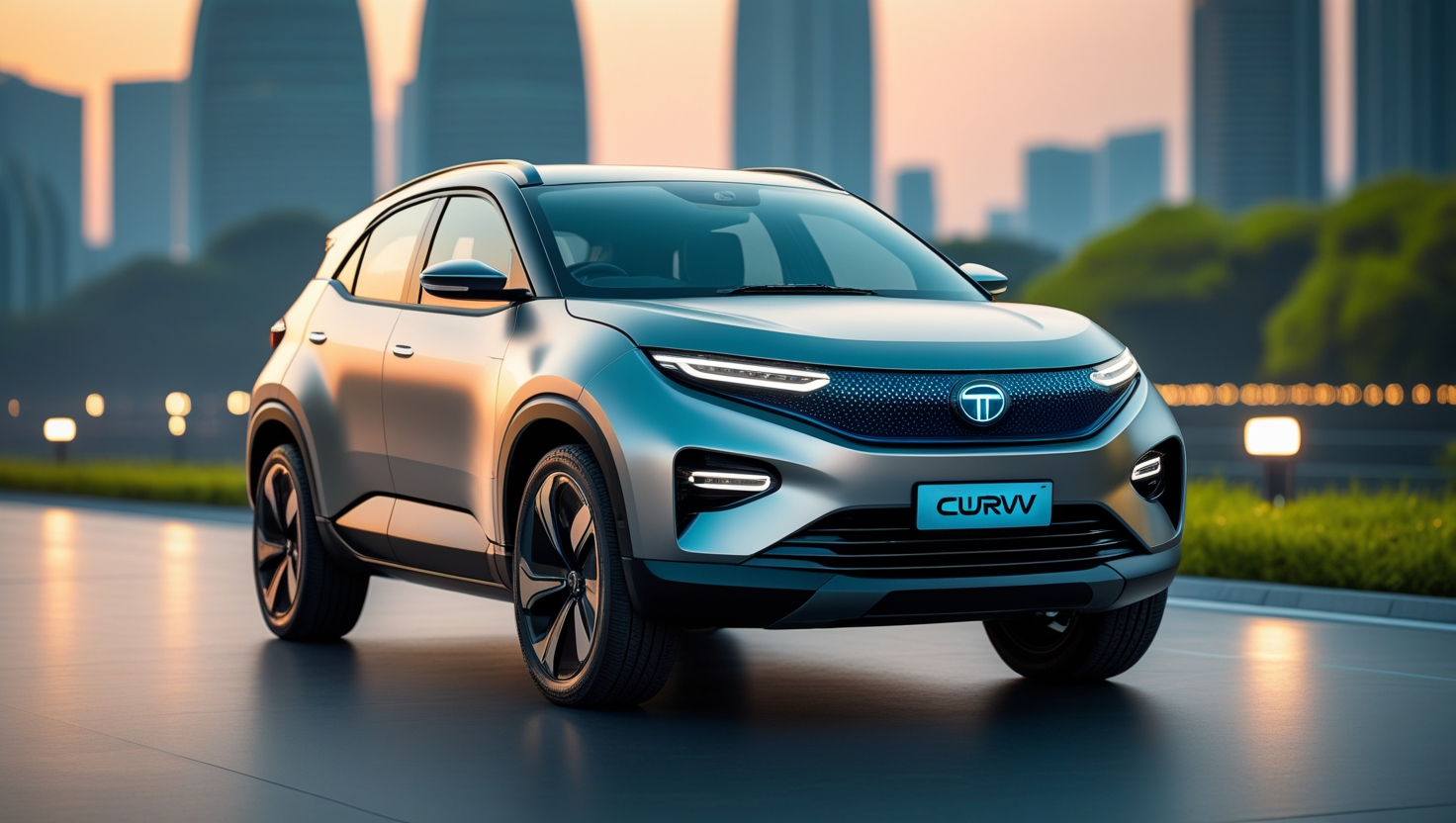Tata Curvv EV 2025 — Full Review, Real-World Range, Price & Should-You-Buy Guide
Tata’s Curvv EV arrived as the company’s mid-size coupe-SUV EV offering — bold styling, multiple battery options, and an emphasis on long-range capability. This detailed guide explains what the Curvv.ev actually offers in 2025: official battery and range options, key specs, tech (ADAS and connectivity), pricing bands, real-world ownership notes, and how it compares to rivals. You’ll get clear facts (launch timeline and manufacturer claims), practical advice on charging and warranty, plus a short buying checklist so you can decide whether the Curvv.ev fits your daily needs or long-distance plans. All core claims are fact-checked against manufacturer releases and trade reporting so you can separate marketing numbers from user expectations.
Introduction — why the Curvv.ev matters in 2025
Tata Motor’s Curvv lineup is notable because it intentionally sits between compact crossovers and larger SUVs with a coupe-like roofline and strong tech focus. The Curvv.ev (battery-electric version) is Tata’s attempt to offer a mid-sized EV with genuinely long range and family-friendly packaging — and that makes it one of the more interesting Indian EV launches of 2024–25. The EV’s multi-battery strategy and claimed long-range figures grabbed headlines immediately after launch.
Quick facts at a glance
Launch & availability: Curvv production/launch activity began with the public launch in 2024, with the EV variant rolled out and test runs in early 2025.
Battery options: Tata lists two Curvv.ev battery pack options (45 kWh and 55 kWh) paired with electric motors of roughly 110–123 kW in higher trims.
Claimed range (MIDC): Tata’s and public sources report optimistic MIDC-style ranges—figures in some reporting and databases show very large numbers (500 km+ in particular test cycles); expect lower real-world WLTP/real driving numbers.
Pricing (EV): Tata lists Curvv.ev pricing starting in a mid/high segment (manufacturer EV page shows a starting price around ₹17.49 lakh ex-showroom for specific trims in 2025 markets—regional taxes and state subsidies will change on-road cost).
Key tech: Connected EV features, Level 2 ADAS in higher trims, multi-drive modes, and Tata’s latest infotainment stack.
(We'll unpack each of these claims with context and sourcing below.)
Design & packaging — coupe-SUV with practical bones
The Curvv.ev follows the “coupe-SUV” trend: a sloping roofline, swept rear, and a relatively long bonnet which together produce a sporty silhouette while keeping a five-seat interior layout. Compared with the Nexon (its close sibling in Tata’s line-up), the Curvv is longer and sits a touch higher in perceived segment positioning, aiming at buyers who want style without stepping up to full-size SUVs. Executed well, this shape gives a distinct look but does reduce rear headroom slightly compared to boxier crossovers — something to check on a test drive.
Powertrain, battery packs and claimed range — the numbers explained
Tata positioned the Curvv.ev with multiple battery choices and motors so buyers can prioritize price, range, or performance:
Battery pack options: reporting and spec sheets indicate two common pack sizes offered for the EV variant — roughly 45 kWh and 55 kWh. These pack sizes align with Tata’s multi-variant strategy for other models.
Motor outputs: higher trims are listed with electric motors around 110 kW to 123 kW, delivering brisk acceleration for a mid-sized SUV.
Claimed range: some manufacturer-adjacent reporting and database listings quote MIDC-style ranges exceeding 500 km for the larger pack—these numbers are test-cycle figures and optimistic relative to real-world driving. Expect city and mixed driving ranges to be noticeably lower once you factor in climate control, highway speeds, payload and traffic.
What that means in practice: a 45 kWh Curvv.ev variant will suit daily use and regular medium-range trips, while the 55 kWh variant is better if you prioritize fewer charging stops on longer trips — but don’t treat MIDC claims as guaranteed real-world numbers. Plan for 15–25% lower range than optimistic test numbers depending on conditions.
Charging: options, speeds and practical planning
Tata’s production EVs typically support AC home charging and DC fast-charging on public networks. For Curvv.ev:
Home (AC) charging: expect standard single-phase or optional three-phase AC charging options depending on region and accessory packs. A home overnight charge will suit the 45 kWh variant for daily commuting.
DC fast charging: higher trims and the larger battery should support DC fast charging—this is critical for reducing downtime on long trips. Manufacturer specs and testing reports suggest practical fast-charge capability, but you should check the exact kW charging curve with dealers at purchase time.
Practical tip: verify the manufacturer’s stated fast-charge kW and state of charge (SoC) charging curve before relying on long-distance planning — many EVs slow charging above ~80% SoC to protect battery health.
Tech & safety — ADAS, connectivity and features
Tata placed notable focus on safety and tech in Curvv trims:
ADAS: Level 2 driver-assist features (lane assist, adaptive cruise, blind-spot monitoring) are reported for higher trims — this is increasingly common in Tata’s newer models.
Connectivity: the Curvv.ev uses Tata’s connected-vehicle stack (OTA updates, connected navigation and telematics). Expect app-based remote functions and telematics features similar to other Tata EVs.
Interior & ergonomics: modern digital cluster(s), a central touchscreen, and feature-rich driver aids—Tata tends to put value into equipment even in mid trims, so the Curvv.ev should look well equipped.
Pricing, trims and value proposition
Tata’s published EV page lists the Curvv.ev starting price in a segment that positions it above entry-level city EVs — with the EV announced at a starting price around ₹17.49 lakh for some trims (ex-showroom) in Tata’s market listings. Remember that actual on-road price will vary by state (registration, subsidies, taxes), optional packs, and dealer discounts. Higher spec Curvv.ev variants with the larger pack, ADAS and premium equipment will push the price higher into the mid-to-upper segment.
Value take: compared with many imported EVs, the Curvv.ev’s local manufacturing and dealer network give it a strong ownership value — service access, parts and localized warranty support matter for mass-adoption buyers.
Warranty & after-sales — what Tata is offering
Tata has publicized stronger battery warranty terms for Curvv.ev owners in 2025, including extended battery warranty options and reported lifetime warranty improvements for first owners in certain markets — a meaningful competitive advantage if applied as marketed. Warranty terms can evolve by market and model year—confirm current warranty packages directly with a dealer before purchase.
Real-world validation — manufacturer road runs & early sales signals
Tata carried out public long-distance runs and publicity drives with Curvv.ev to showcase battery durability and charging infrastructure interaction — such real-world demos aim to demonstrate practical range and robustness across terrains. Sales updates in 2025 indicate the Curvv (both ICE and EV variants) moved into the market with early dispatch and sales numbers being reported in trade updates. Use those early sales snapshots as an indicator of demand and dealer confidence, but not as a substitute for real owner reviews.
Competitors — who you should compare against
If you’re shopping for a Curvv.ev consider these competing models (roughly similar segment or range targets):
Tata Nexon.ev (higher trims) — internal comparison within Tata for buyers balancing price vs size.
MG ZS EV / Comet / Other local mid-SUV EVs — similar size and equipment in some markets.
BYD Yuan Plus / global Chinese EVs — depending on your region, some imported models aim at similar range or price points.
When comparing, match actual on-road prices, warranty specifics, charging infrastructure compatibility in your area, and dealer support network.
Ownership costs & resale expectations
EV ownership cost benefits (lower fuel cost per km, fewer mechanical maintenance items) are balanced by battery degradation concerns and eventual high-voltage component checks. Tata’s expanded battery warranty for Curvv.ev can materially lower ownership risk and improve resale confidence. For buying used later, battery health reports and original warranty transfer rules will be decisive for pricing. Always factor battery replacement economics and available BaaS/extended warranty packages into total cost of ownership calculations.
Test-drive checklist — what to confirm in person
Real-world range: ask the dealer for a demo of estimated range at different driving modes.
Charging speed & compatibility: check DC charge acceptance and charger compatibility (connector type and expected kW).
Interior space & headroom: the coupe profile looks sporty but can limit rear headroom—sit in the rear seats.
ADAS behaviour: verify lane-keeping, adaptive cruise and emergency assist in controlled conditions.
Warranty & service plans: get warranty documents and check battery warranty terms in writing.
Pros & cons — quick summary
Pros
Distinct coupe-SUV styling with competitive tech.
Multiple battery options for flexible range/price choices.
Strong dealer & service network from Tata; attractive warranty messaging.
Cons
Manufacturer range numbers are optimistic test-cycle figures—real-world range will be lower.
Coupe roofline can compromise rear headroom and cargo packaging compared with boxier rivals.
Final verdict — who should buy the Curvv.ev in 2025?
Buy the Curvv.ev if:
You want a locally-made mid-sized EV with strong dealer support and modern tech.
You value longer theoretical range and prefer the flexibility of two battery options.
You prioritize features like Level 2 ADAS, connected services, and a premium look without paying full luxury prices.
Consider alternatives if:
You require absolute maximum rear passenger headroom or need the most cargo volume for regular hauling.
You live in an area where DC fast-charging networks are sparse and you frequently do very long highway miles where real-world range becomes critical.
Conclusion
The Tata Curvv.ev is an important step for Tata’s EV line-up — it combines striking coupe-SUV styling with a multi-battery EV strategy, advanced tech and Tata’s growing EV ecosystem. The manufacturer’s published specs and early road demonstrations show ambition (and strong claimed ranges), but buyers should treat test-cycle figures cautiously and verify charging and warranty details locally. If you want a stylish, feature-packed Indian EV with solid after-sales support, the Curvv.ev is a contender worth a test drive — and for many buyers the larger battery variant will deliver the most practical balance between range and convenience.












